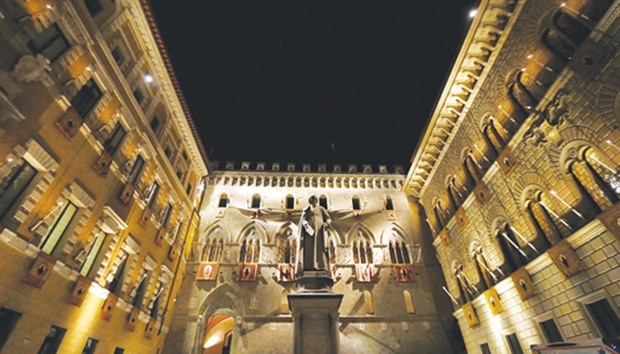Italy’s plan for an €8.8bn ($9.8bn) bailout of Banca Monte dei Paschi di Siena faces resistance from the European Central Bank, which is concerned the lender may struggle to maintain capital buffers as it tries to get back on its feet, according to people with knowledge of the matter.
The ECB’s oversight arm has signalled that the current rescue plan doesn’t do enough to ensure that Monte Paschi will comfortably meet supervisory capital requirements in the next few years, as the bank offloads about €30bn of bad loans through a securitisation, the people said, asking not to be identified because the rescue talks are private.
Five months after Monte Paschi requested help, the Italian government, the ECB, the European Commission and the bank have yet to reach a final agreement on how the bank should be restructured as part of the bailout or how much capital it will need to return to viability. Under European Union state-aid rules, capital-raising plans must ensure that a bank can return to lasting health in a reasonable amount of time; otherwise, it “should be wound down in an orderly manner.”
Italy is trying to prop up Monte Paschi using a provision in the EU’s bank-failure rules that allows governments to provide state aid to viable banks to address a capital shortfall identified in a stress test. Monte Paschi was the worst performer in the EU’s 2016 exam.
Raising more funds now has been ruled out, two of the people said. The ECB recently asked for changes to Monte Paschi’s securitisation plan to ensure a greater role for private investors, they said. The ECB objected to the bank’s proposal to assign the junior tranches to the Italian Treasury, which would have absorbed capital, one person said. No deal has been reached, and the terms of the sale are still under review.
The talks are proceeding constructively and confidence is high that a deal will be reached, three people said. The commission is expected to reach a decision in the next few weeks, Italian Finance Minister Pier Carlo Padoan’s chief of staff Fabrizio Pagani said this week. Il Sole 24 Ore reported on May 18 that the commission is expected to give technical approval to the bank’s restructuring plan next week.
Monte Paschi said in March that the ECB had completed its inspection of the loan book, and that the outcome would be “taken into account when assessing the bank’s solvency.” The ECB hasn’t made the results public, but it came away with serious concerns about the quality of the bank’s assets, two people said.
While some concerns remain, a workaround has been found to keep the talks moving forward, the people said.
EU rules prohibit using public money to cover losses that a solvent bank “has incurred or is likely to incur in the near future.”
The rescue outlined by the Bank of Italy contains about €4.2bn generated by converting Monte Paschi’s subordinated debt to equity, though the Italian government would later compensate retail investors for about €2bn.
Daniele Nouy, head of supervision at the ECB, said on May 15 that the issue of asset quality may require “additional discussions to see whether incurred losses are really covered by private money.” That’s because the 2016 EU stress test, the basis of Italy’s bailout plan, wasn’t accompanied by a detailed review of banks’ assets, she said.
The ECB’s concerns about Monte Paschi go back to its December decision to declare the bank solvent, and therefore eligible for a precautionary recapitalisation. Confronted with what they saw as a political agreement to bail out the lender, dissenters on the 19-nation Supervisory Board went along with the consensus despite their concerns about the bank’s health.
Spokespeople for the ECB, the European Commission, the Italian Treasury and Monte Paschi declined to comment.

The Monte dei Paschi headquarters in Siena, Italy. The ECB’s oversight arm has signalled that the current rescue plan doesn’t do enough to ensure that Monte Paschi will comfortably meet supervisory capital requirements in the next few years.


